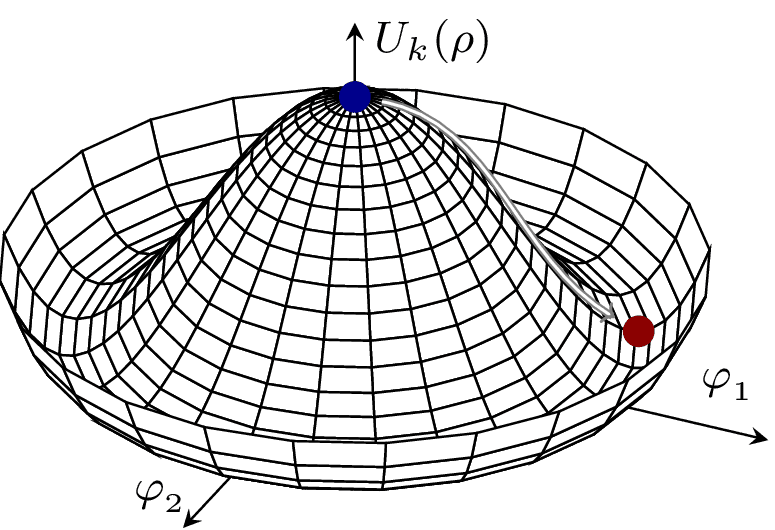Mexican Hat
Tags
The Mexican hat potential exhibits spontaneous symmetry breaking (SSB), a process by which a physical system starting in a symmetric state spontaneously enters and remains in an asymmetric state. This usually applies to systems whose equations of motion obey a set of symmetries while the lowest-energy state(s) do(es) not. When the system assumes one of its ground states, its symmetry is broken even though the Lagrangian as a whole retains it. See https://janosh.github.io/tikz/higgs-potential for a very similar image.
In this image, the system starts out in the naive -invariant vacuum (blue dot) but quantum fluctuations quickly push it into the real vacuum (red dot) where is broken down to .

Edit
Download
Code
mexican-hat.tex (32 lines)
\documentclass[svgnames]{standalone}
\usepackage{pgfplots}
\pgfplotsset{compat=1.8}
\usetikzlibrary{arrows.meta}
\begin{document}
\begin{tikzpicture}[font=\footnotesize]
\begin{axis}[
axis lines=center,
axis equal,
domain=0:360,
y domain=0:1.25,
y axis line style=stealth-,
y label style={at={(0.35,0.18)}},
xmax=1.6,zmax=1.3,
xlabel = $\varphi_{_1}$,
ylabel=$\varphi_{_2}$,
zlabel=$U_k(\rho)$,
ticks=none
]
\addplot3 [surf,shader=flat,draw=black,fill=white,z buffer=sort] ({sin(x)*y}, {cos(x)*y}, {(y^2-1)^2});
\coordinate (center) at (axis cs:0,0,1);
\coordinate (minimum) at (axis cs:{cos(30)},{sin(30)},0);
\end{axis}
\fill[DarkBlue] (center) circle (0.1);
\fill[DarkRed] (minimum) circle (0.1);
\draw (center) edge[shorten <=5,shorten >=5,out=-10,in=150,double,draw=gray,double distance=0.5,-{>[length=2,line width=0.5]}] (minimum);
\end{tikzpicture}
\end{document}